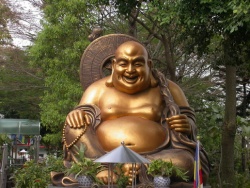School doctrines (bodhisattva)
Some sutras said a beginner would take 3–22 countless eons (mahāsaṃkhyeya kalpas) to become a buddha. Pure Land Buddhism suggests buddhists go to the pure lands to practice. Tiantai, Huayan, Zen and Vajrayāna schools say they teach ways to attain buddhahood within one karmic cycle.
Various traditions within Buddhism believe in specific bodhisattvas. Some bodhisattvas appear across traditions, but due to language barriers may be seen as separate entities. For example, Tibetan Buddhists believe in various forms of Chenrezig, who is Avalokiteśvara in Sanskrit, Guanyin (Kwan-yin or Kuan-yin) in China and Korea, Quan Am in Vietnam, and Kannon (formerly spelled and pronounced: Kwannon) in Japan. Followers of Tibetan Buddhism consider the Dalai Lamas and the Karmapas to be an emanation of Chenrezig, the Bodhisattva of Compassion.
Kṣitigarbha is another popular bodhisattva in Japan and China. He is known for aiding those who are lost. His greatest compassionate vow is:
- If I do not go to the hell to help the suffering beings there, who else will go? ... if the hells are not empty I will not become a Buddha. Only when all living beings have been saved, will I attain Bodhi.
The place of a bodhisattva's earthly deeds, such as the achievement of enlightenment or the acts of dharma, is known as a bodhimanda, and may be a site of pilgrimage. Many temples and monasteries are famous as bodhimandas; for instance, the island of Putuoshan, located off the coast of Ningbo, is venerated by Chinese Buddhists as the bodhimanda of Avalokiteśvara. Perhaps the most famous bodhimanda of all is the bodhi tree under which Śākyamuṇi achieved buddhahood.
